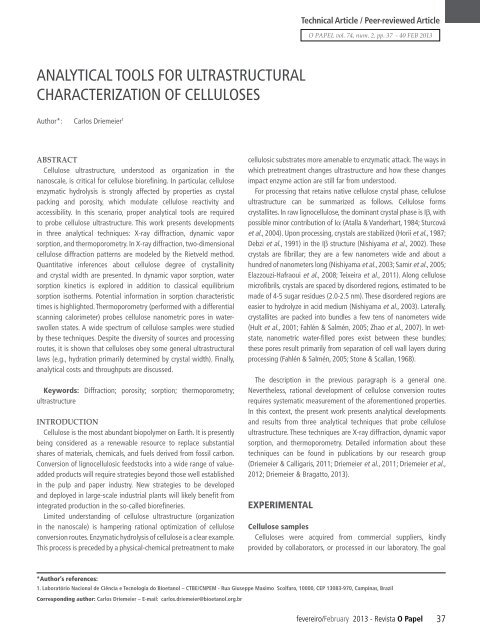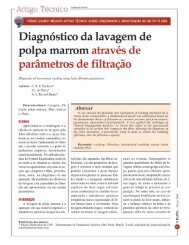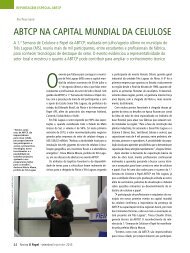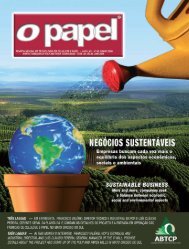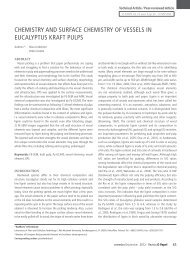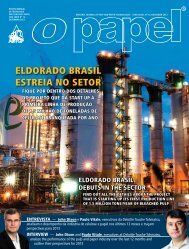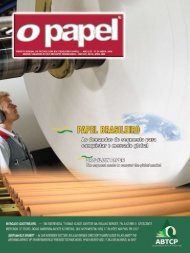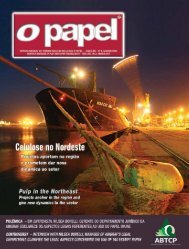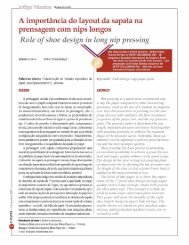A EVOLUÃÃO DA INDÃSTRIA DE CELULOSE E ... - Revista O Papel
A EVOLUÃÃO DA INDÃSTRIA DE CELULOSE E ... - Revista O Papel
A EVOLUÃÃO DA INDÃSTRIA DE CELULOSE E ... - Revista O Papel
You also want an ePaper? Increase the reach of your titles
YUMPU automatically turns print PDFs into web optimized ePapers that Google loves.
Technical Article / Peer-reviewed ArticleO PAPEL vol. 74, num. 2, pp. 37 - 40 FEB 2013ANALYTICAL TOOLS FOR ULTRASTRUCTURALCHARACTERIZATION OF CELLULOSESAuthor*: Carlos Driemeier 1ABSTRACTCellulose ultrastructure, understood as organization in thenanoscale, is critical for cellulose biorefining. In particular, celluloseenzymatic hydrolysis is strongly affected by properties as crystalpacking and porosity, which modulate cellulose reactivity andaccessibility. In this scenario, proper analytical tools are requiredto probe cellulose ultrastructure. This work presents developmentsin three analytical techniques: X-ray diffraction, dynamic vaporsorption, and thermoporometry. In X-ray diffraction, two-dimensionalcellulose diffraction patterns are modeled by the Rietveld method.Quantitative inferences about cellulose degree of crystallinityand crystal width are presented. In dynamic vapor sorption, watersorption kinetics is explored in addition to classical equilibriumsorption isotherms. Potential information in sorption characteristictimes is highlighted. Thermoporometry (performed with a differentialscanning calorimeter) probes cellulose nanometric pores in waterswollenstates. A wide spectrum of cellulose samples were studiedby these techniques. Despite the diversity of sources and processingroutes, it is shown that celluloses obey some general ultrastructurallaws (e.g., hydration primarily determined by crystal width). Finally,analytical costs and throughputs are discussed.Keywords: Diffraction; porosity; sorption; thermoporometry;ultrastructureINTRODUCTIONCellulose is the most abundant biopolymer on Earth. It is presentlybeing considered as a renewable resource to replace substantialshares of materials, chemicals, and fuels derived from fossil carbon.Conversion of lignocellulosic feedstocks into a wide range of valueaddedproducts will require strategies beyond those well establishedin the pulp and paper industry. New strategies to be developedand deployed in large-scale industrial plants will likely benefit fromintegrated production in the so-called biorefineries.Limited understanding of cellulose ultrastructure (organizationin the nanoscale) is hampering rational optimization of celluloseconversion routes. Enzymatic hydrolysis of cellulose is a clear example.This process is preceded by a physical-chemical pretreatment to makecellulosic substrates more amenable to enzymatic attack. The ways inwhich pretreatment changes ultrastructure and how these changesimpact enzyme action are still far from understood.For processing that retains native cellulose crystal phase, celluloseultrastructure can be summarized as follows. Cellulose formscrystallites. In raw lignocellulose, the dominant crystal phase is Iβ, withpossible minor contribution of Iα (Atalla & Vanderhart, 1984; Sturcováet al., 2004). Upon processing, crystals are stabilized (Horii et al., 1987;Debzi et al., 1991) in the Iβ structure (Nishiyama et al., 2002). Thesecrystals are fibrillar; they are a few nanometers wide and about ahundred of nanometers long (Nishiyama et al., 2003; Samir et al., 2005;Elazzouzi-Hafraoui et al., 2008; Teixeira et al., 2011). Along cellulosemicrofibrils, crystals are spaced by disordered regions, estimated to bemade of 4-5 sugar residues (2.0-2.5 nm). These disordered regions areeasier to hydrolyze in acid medium (Nishiyama et al., 2003). Laterally,crystallites are packed into bundles a few tens of nanometers wide(Hult et al., 2001; Fahlén & Salmén, 2005; Zhao et al., 2007). In wetstate,nanometric water-filled pores exist between these bundles;these pores result primarily from separation of cell wall layers duringprocessing (Fahlén & Salmén, 2005; Stone & Scallan, 1968).The description in the previous paragraph is a general one.Nevertheless, rational development of cellulose conversion routesrequires systematic measurement of the aforementioned properties.In this context, the present work presents analytical developmentsand results from three analytical techniques that probe celluloseultrastructure. These techniques are X-ray diffraction, dynamic vaporsorption, and thermoporometry. Detailed information about thesetechniques can be found in publications by our research group(Driemeier & Calligaris, 2011; Driemeier et al., 2011; Driemeier et al.,2012; Driemeier & Bragatto, 2013).EXPERIMENTALCellulose samplesCelluloses were acquired from commercial suppliers, kindlyprovided by collaborators, or processed in our laboratory. The goal*Author’s references:1. Laboratório Nacional de Ciência e Tecnologia do Bioetanol – CTBE/CNPEM - Rua Giuseppe Maximo Scolfaro, 10000, CEP 13083-970, Campinas, BrazilCorresponding author: Carlos Driemeier – E-mail: carlos.driemeier@bioetanol.org.brfevereiro/February 2013 - <strong>Revista</strong> O <strong>Papel</strong>37


